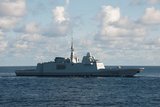WIN-T SNE increases communications reach
General Dynamics said in an 8 January release that the Warfigher Information Network-Tactical (WIN-T) Soldier Network Extension (SNE) increased communications reach and improved call-for-fire response time significantly.
These results were found by a US Army field artillery team during a WIN-T Increment 2 Development Test 2. The soldiers were part of the 4th Battalion, 27th Field Artillery Regiment (4/27), 2nd Brigade Combat Team, 1st Armored Division. The SNE was found to have supported call-for-fire mission 'threads' during the Network Integration Evaluation 15.1 and the Development Test 2. The tests took place at Fort Bliss, Texas, and White Sands Missile Range, New Mexico in October and November 2013.
Legacy line-of-site (LOS) radios were used by fire support officers and forward observers before the SNE to transmit counter fire and fire calls at the far edges of a mission area. They only work when the radios are in each other's line of sight, making communication difficult when soldiers work in mountainous or remote locations.
The tests saw the team use SNE satellite communications to exchange information from any location within the Brigade's mission area.
Capt. Sean Williams, the team's battery commander, said: 'Before, we were constrained by terrestrial location systems; since this is a satellite-based system, there is much greater range to digitally call for fire and process fires missions on the battlefield.'
Chris Marzilli, president, General Dynamics Mission Systems, added: 'Every day, digital-savvy soldiers discover new capabilities using the SNE. With recent improvements that make the SNE easier to learn and use, soldiers find creative ways to increase their mission effectiveness while improving their safety.'
More from Digital Battlespace
-
![Babcock nears first customer for Nomad AI translation tool]()
Babcock nears first customer for Nomad AI translation tool
Nomad can provide militaries with real-time intelligence, saving critical time on the battlefield.
-
![AUSA 2025: Israel’s Asio Technologies to supply hundreds of improved Taurus tactical systems]()
AUSA 2025: Israel’s Asio Technologies to supply hundreds of improved Taurus tactical systems
Taurus operates alongside the Israel Defense Forces’ Orion system which supports mission management across tens of thousands of manoeuvring forces, from squad leaders to battalion commanders.
-
![AUSA 2025: Kopin pushes micro-LED plans as China moves faster]()
AUSA 2025: Kopin pushes micro-LED plans as China moves faster
The plan for the new displays follows fresh investment in Kopin’s European facilities by Theon and an order for head-up displays in fielded aircraft, with funding from the US Department of Defense.
-
![AUSA 2025: Persistent Systems to complete its largest order by year’s end]()
AUSA 2025: Persistent Systems to complete its largest order by year’s end
Persistent Systems received its largest ever single order for its MPU5 devices and other systems earlier this month and has already delivered the 50 units to the US Army’s 4th Infantry Division.
-
![Aselsan brings in dozens of companies and systems under the Steel Dome umbrella]()
Aselsan brings in dozens of companies and systems under the Steel Dome umbrella
Turkey has joined the family of countries attempting to establish a multilayered air defence system with government approval in August 2024 for the effort landed by Aselsan. Dubbed Steel Dome, the programme joins Israel’s Iron Dome, the US Golden Dome, India’s Mission Sudarshan Chakra and South Korea’s low-altitude missile defence system.
-
![DSEI 2025: MARSS unveils new agnostic multidomain C4 system]()
DSEI 2025: MARSS unveils new agnostic multidomain C4 system
MARSS’ NiDAR system has been deployed using sensors from static platforms to provide detection and protection for static sights, such as critical infrastructure, ports and military bases.




























